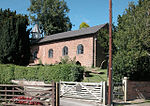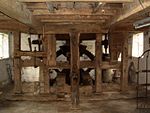St John the Baptist's Church, Guilden Sutton
19th-century Church of England church buildingsChurch of England church buildings in CheshireChurches completed in 1815Diocese of ChesterGrade II listed churches in Cheshire

St John the Baptist's Church is in the village of Guilden Sutton, near Chester, Cheshire, England. It is recorded in the National Heritage List for England as a designated Grade II listed building. It is an active Anglican parish church. The church is in the diocese of Chester, the archdeaconry of Chester and the deanery of Chester. Its benefice is combined with that of St Peter, Plemstall.
Excerpt from the Wikipedia article St John the Baptist's Church, Guilden Sutton (License: CC BY-SA 3.0, Authors, Images).St John the Baptist's Church, Guilden Sutton
The Vetches,
Geographical coordinates (GPS) Address Nearby Places Show on map
Geographical coordinates (GPS)
| Latitude | Longitude |
|---|---|
| N 53.2078 ° | E -2.8265 ° |
Address
The Vetches
CH3 7HL , Guilden Sutton
England, United Kingdom
Open on Google Maps









